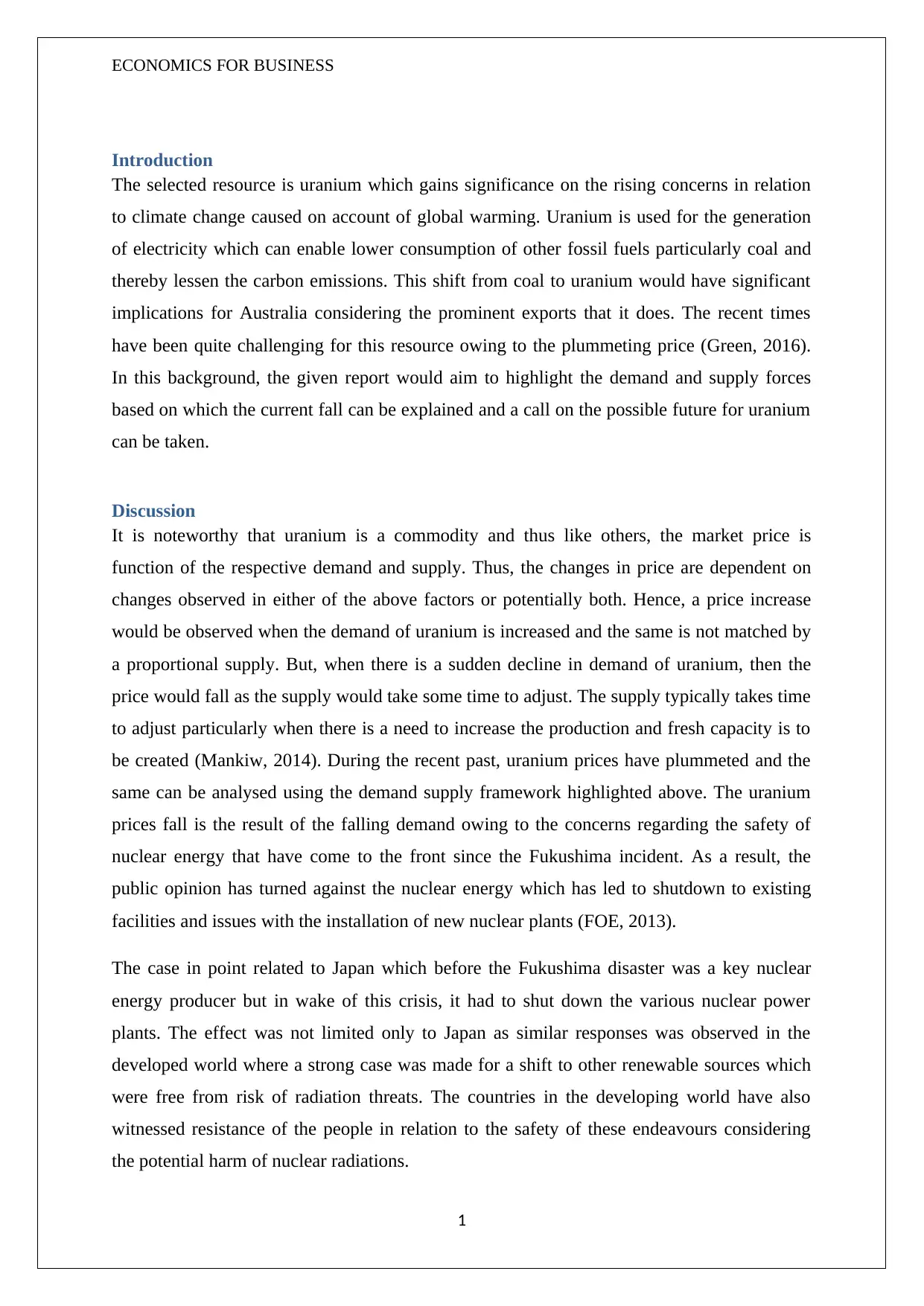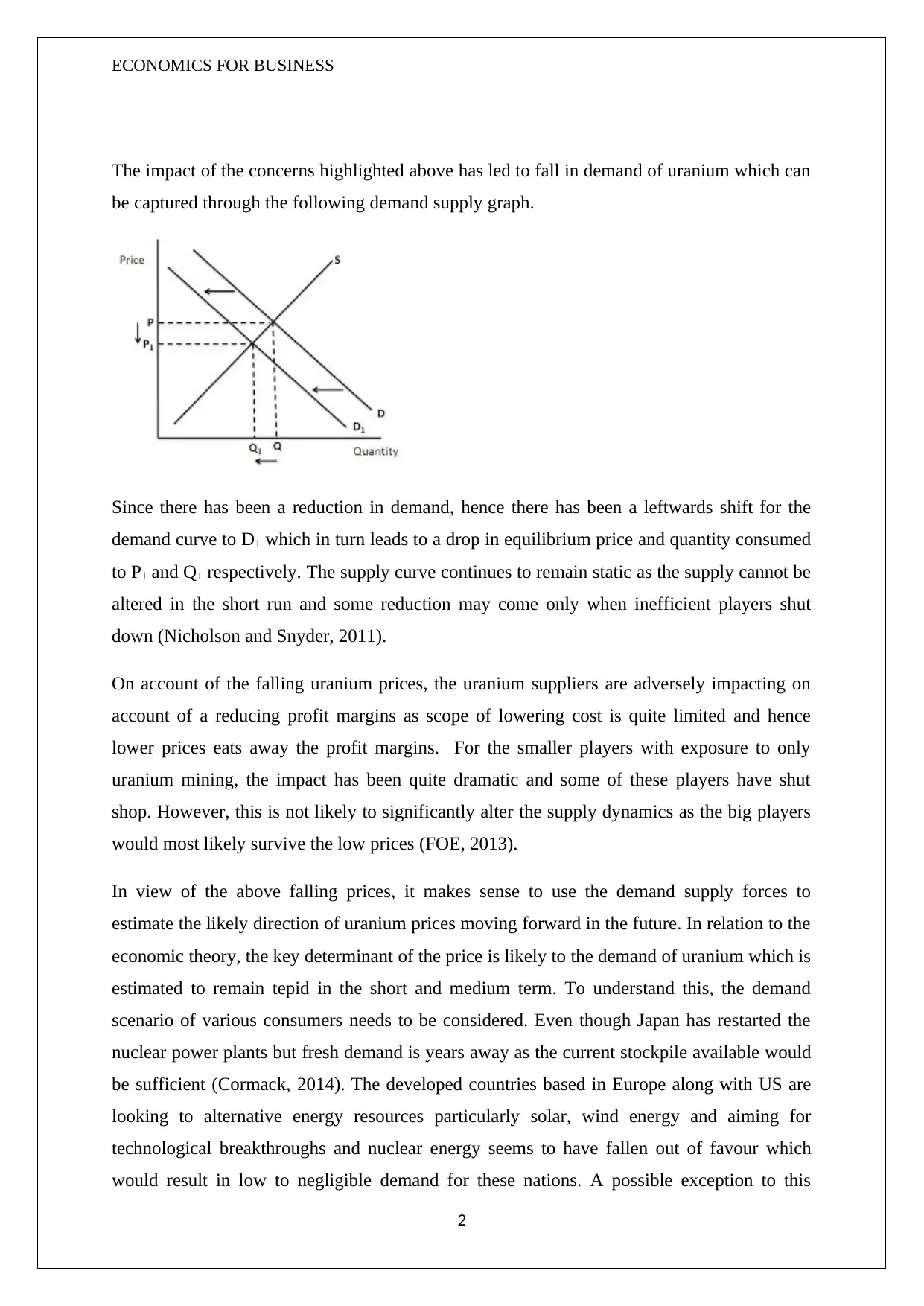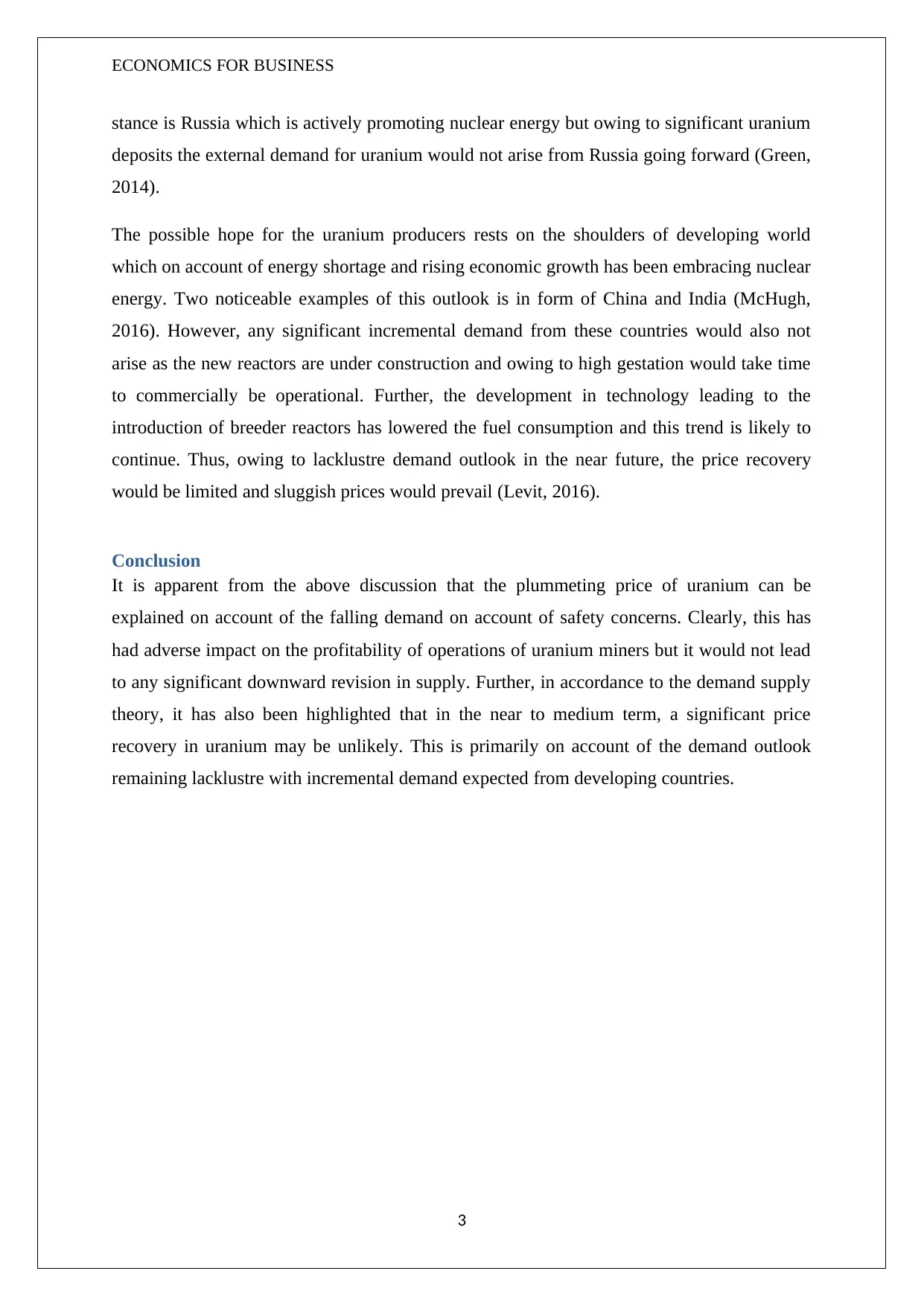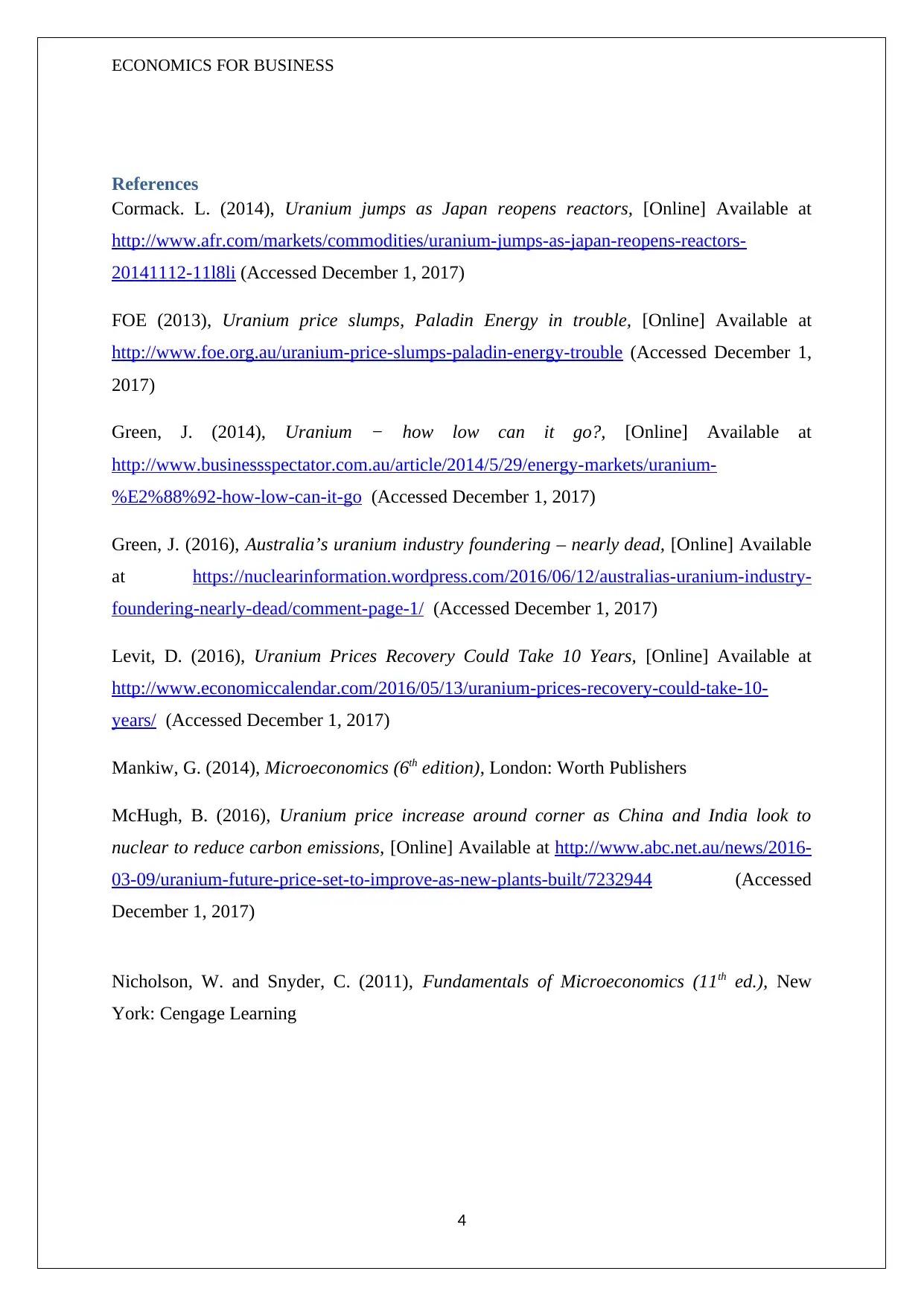HI5003 Economics for Business: Uranium Demand, Supply & Future
VerifiedAdded on 2023/06/16
|5
|1359
|477
Report
AI Summary
This report examines the dynamics of the uranium market, focusing on the interplay of demand and supply forces. It explains the recent price decline in uranium due to safety concerns following the Fukushima incident, which led to reduced demand and subsequent market adjustments. The analysis considers the demand scenarios in various countries, including Japan, developed nations in Europe and the US, and developing countries like China and India. The report concludes that a significant price recovery in the near to medium term is unlikely due to a tepid demand outlook, despite potential incremental demand from developing nations. The document emphasizes the adverse impact on uranium miners' profitability and suggests that while some smaller players may exit the market, larger players are likely to weather the low prices. Desklib offers a wealth of similar solved assignments and resources for students.

Economics For Business
Uranium
Student Id:
Uranium
Student Id:
Paraphrase This Document
Need a fresh take? Get an instant paraphrase of this document with our AI Paraphraser

ECONOMICS FOR BUSINESS
Introduction
The selected resource is uranium which gains significance on the rising concerns in relation
to climate change caused on account of global warming. Uranium is used for the generation
of electricity which can enable lower consumption of other fossil fuels particularly coal and
thereby lessen the carbon emissions. This shift from coal to uranium would have significant
implications for Australia considering the prominent exports that it does. The recent times
have been quite challenging for this resource owing to the plummeting price (Green, 2016).
In this background, the given report would aim to highlight the demand and supply forces
based on which the current fall can be explained and a call on the possible future for uranium
can be taken.
Discussion
It is noteworthy that uranium is a commodity and thus like others, the market price is
function of the respective demand and supply. Thus, the changes in price are dependent on
changes observed in either of the above factors or potentially both. Hence, a price increase
would be observed when the demand of uranium is increased and the same is not matched by
a proportional supply. But, when there is a sudden decline in demand of uranium, then the
price would fall as the supply would take some time to adjust. The supply typically takes time
to adjust particularly when there is a need to increase the production and fresh capacity is to
be created (Mankiw, 2014). During the recent past, uranium prices have plummeted and the
same can be analysed using the demand supply framework highlighted above. The uranium
prices fall is the result of the falling demand owing to the concerns regarding the safety of
nuclear energy that have come to the front since the Fukushima incident. As a result, the
public opinion has turned against the nuclear energy which has led to shutdown to existing
facilities and issues with the installation of new nuclear plants (FOE, 2013).
The case in point related to Japan which before the Fukushima disaster was a key nuclear
energy producer but in wake of this crisis, it had to shut down the various nuclear power
plants. The effect was not limited only to Japan as similar responses was observed in the
developed world where a strong case was made for a shift to other renewable sources which
were free from risk of radiation threats. The countries in the developing world have also
witnessed resistance of the people in relation to the safety of these endeavours considering
the potential harm of nuclear radiations.
1
Introduction
The selected resource is uranium which gains significance on the rising concerns in relation
to climate change caused on account of global warming. Uranium is used for the generation
of electricity which can enable lower consumption of other fossil fuels particularly coal and
thereby lessen the carbon emissions. This shift from coal to uranium would have significant
implications for Australia considering the prominent exports that it does. The recent times
have been quite challenging for this resource owing to the plummeting price (Green, 2016).
In this background, the given report would aim to highlight the demand and supply forces
based on which the current fall can be explained and a call on the possible future for uranium
can be taken.
Discussion
It is noteworthy that uranium is a commodity and thus like others, the market price is
function of the respective demand and supply. Thus, the changes in price are dependent on
changes observed in either of the above factors or potentially both. Hence, a price increase
would be observed when the demand of uranium is increased and the same is not matched by
a proportional supply. But, when there is a sudden decline in demand of uranium, then the
price would fall as the supply would take some time to adjust. The supply typically takes time
to adjust particularly when there is a need to increase the production and fresh capacity is to
be created (Mankiw, 2014). During the recent past, uranium prices have plummeted and the
same can be analysed using the demand supply framework highlighted above. The uranium
prices fall is the result of the falling demand owing to the concerns regarding the safety of
nuclear energy that have come to the front since the Fukushima incident. As a result, the
public opinion has turned against the nuclear energy which has led to shutdown to existing
facilities and issues with the installation of new nuclear plants (FOE, 2013).
The case in point related to Japan which before the Fukushima disaster was a key nuclear
energy producer but in wake of this crisis, it had to shut down the various nuclear power
plants. The effect was not limited only to Japan as similar responses was observed in the
developed world where a strong case was made for a shift to other renewable sources which
were free from risk of radiation threats. The countries in the developing world have also
witnessed resistance of the people in relation to the safety of these endeavours considering
the potential harm of nuclear radiations.
1

ECONOMICS FOR BUSINESS
The impact of the concerns highlighted above has led to fall in demand of uranium which can
be captured through the following demand supply graph.
Since there has been a reduction in demand, hence there has been a leftwards shift for the
demand curve to D1 which in turn leads to a drop in equilibrium price and quantity consumed
to P1 and Q1 respectively. The supply curve continues to remain static as the supply cannot be
altered in the short run and some reduction may come only when inefficient players shut
down (Nicholson and Snyder, 2011).
On account of the falling uranium prices, the uranium suppliers are adversely impacting on
account of a reducing profit margins as scope of lowering cost is quite limited and hence
lower prices eats away the profit margins. For the smaller players with exposure to only
uranium mining, the impact has been quite dramatic and some of these players have shut
shop. However, this is not likely to significantly alter the supply dynamics as the big players
would most likely survive the low prices (FOE, 2013).
In view of the above falling prices, it makes sense to use the demand supply forces to
estimate the likely direction of uranium prices moving forward in the future. In relation to the
economic theory, the key determinant of the price is likely to the demand of uranium which is
estimated to remain tepid in the short and medium term. To understand this, the demand
scenario of various consumers needs to be considered. Even though Japan has restarted the
nuclear power plants but fresh demand is years away as the current stockpile available would
be sufficient (Cormack, 2014). The developed countries based in Europe along with US are
looking to alternative energy resources particularly solar, wind energy and aiming for
technological breakthroughs and nuclear energy seems to have fallen out of favour which
would result in low to negligible demand for these nations. A possible exception to this
2
The impact of the concerns highlighted above has led to fall in demand of uranium which can
be captured through the following demand supply graph.
Since there has been a reduction in demand, hence there has been a leftwards shift for the
demand curve to D1 which in turn leads to a drop in equilibrium price and quantity consumed
to P1 and Q1 respectively. The supply curve continues to remain static as the supply cannot be
altered in the short run and some reduction may come only when inefficient players shut
down (Nicholson and Snyder, 2011).
On account of the falling uranium prices, the uranium suppliers are adversely impacting on
account of a reducing profit margins as scope of lowering cost is quite limited and hence
lower prices eats away the profit margins. For the smaller players with exposure to only
uranium mining, the impact has been quite dramatic and some of these players have shut
shop. However, this is not likely to significantly alter the supply dynamics as the big players
would most likely survive the low prices (FOE, 2013).
In view of the above falling prices, it makes sense to use the demand supply forces to
estimate the likely direction of uranium prices moving forward in the future. In relation to the
economic theory, the key determinant of the price is likely to the demand of uranium which is
estimated to remain tepid in the short and medium term. To understand this, the demand
scenario of various consumers needs to be considered. Even though Japan has restarted the
nuclear power plants but fresh demand is years away as the current stockpile available would
be sufficient (Cormack, 2014). The developed countries based in Europe along with US are
looking to alternative energy resources particularly solar, wind energy and aiming for
technological breakthroughs and nuclear energy seems to have fallen out of favour which
would result in low to negligible demand for these nations. A possible exception to this
2
⊘ This is a preview!⊘
Do you want full access?
Subscribe today to unlock all pages.

Trusted by 1+ million students worldwide

ECONOMICS FOR BUSINESS
stance is Russia which is actively promoting nuclear energy but owing to significant uranium
deposits the external demand for uranium would not arise from Russia going forward (Green,
2014).
The possible hope for the uranium producers rests on the shoulders of developing world
which on account of energy shortage and rising economic growth has been embracing nuclear
energy. Two noticeable examples of this outlook is in form of China and India (McHugh,
2016). However, any significant incremental demand from these countries would also not
arise as the new reactors are under construction and owing to high gestation would take time
to commercially be operational. Further, the development in technology leading to the
introduction of breeder reactors has lowered the fuel consumption and this trend is likely to
continue. Thus, owing to lacklustre demand outlook in the near future, the price recovery
would be limited and sluggish prices would prevail (Levit, 2016).
Conclusion
It is apparent from the above discussion that the plummeting price of uranium can be
explained on account of the falling demand on account of safety concerns. Clearly, this has
had adverse impact on the profitability of operations of uranium miners but it would not lead
to any significant downward revision in supply. Further, in accordance to the demand supply
theory, it has also been highlighted that in the near to medium term, a significant price
recovery in uranium may be unlikely. This is primarily on account of the demand outlook
remaining lacklustre with incremental demand expected from developing countries.
3
stance is Russia which is actively promoting nuclear energy but owing to significant uranium
deposits the external demand for uranium would not arise from Russia going forward (Green,
2014).
The possible hope for the uranium producers rests on the shoulders of developing world
which on account of energy shortage and rising economic growth has been embracing nuclear
energy. Two noticeable examples of this outlook is in form of China and India (McHugh,
2016). However, any significant incremental demand from these countries would also not
arise as the new reactors are under construction and owing to high gestation would take time
to commercially be operational. Further, the development in technology leading to the
introduction of breeder reactors has lowered the fuel consumption and this trend is likely to
continue. Thus, owing to lacklustre demand outlook in the near future, the price recovery
would be limited and sluggish prices would prevail (Levit, 2016).
Conclusion
It is apparent from the above discussion that the plummeting price of uranium can be
explained on account of the falling demand on account of safety concerns. Clearly, this has
had adverse impact on the profitability of operations of uranium miners but it would not lead
to any significant downward revision in supply. Further, in accordance to the demand supply
theory, it has also been highlighted that in the near to medium term, a significant price
recovery in uranium may be unlikely. This is primarily on account of the demand outlook
remaining lacklustre with incremental demand expected from developing countries.
3
Paraphrase This Document
Need a fresh take? Get an instant paraphrase of this document with our AI Paraphraser

ECONOMICS FOR BUSINESS
References
Cormack. L. (2014), Uranium jumps as Japan reopens reactors, [Online] Available at
http://www.afr.com/markets/commodities/uranium-jumps-as-japan-reopens-reactors-
20141112-11l8li (Accessed December 1, 2017)
FOE (2013), Uranium price slumps, Paladin Energy in trouble, [Online] Available at
http://www.foe.org.au/uranium-price-slumps-paladin-energy-trouble (Accessed December 1,
2017)
Green, J. (2014), Uranium − how low can it go?, [Online] Available at
http://www.businessspectator.com.au/article/2014/5/29/energy-markets/uranium-
%E2%88%92-how-low-can-it-go (Accessed December 1, 2017)
Green, J. (2016), Australia’s uranium industry foundering – nearly dead, [Online] Available
at https://nuclearinformation.wordpress.com/2016/06/12/australias-uranium-industry-
foundering-nearly-dead/comment-page-1/ (Accessed December 1, 2017)
Levit, D. (2016), Uranium Prices Recovery Could Take 10 Years, [Online] Available at
http://www.economiccalendar.com/2016/05/13/uranium-prices-recovery-could-take-10-
years/ (Accessed December 1, 2017)
Mankiw, G. (2014), Microeconomics (6th edition), London: Worth Publishers
McHugh, B. (2016), Uranium price increase around corner as China and India look to
nuclear to reduce carbon emissions, [Online] Available at http://www.abc.net.au/news/2016-
03-09/uranium-future-price-set-to-improve-as-new-plants-built/7232944 (Accessed
December 1, 2017)
Nicholson, W. and Snyder, C. (2011), Fundamentals of Microeconomics (11th ed.), New
York: Cengage Learning
4
References
Cormack. L. (2014), Uranium jumps as Japan reopens reactors, [Online] Available at
http://www.afr.com/markets/commodities/uranium-jumps-as-japan-reopens-reactors-
20141112-11l8li (Accessed December 1, 2017)
FOE (2013), Uranium price slumps, Paladin Energy in trouble, [Online] Available at
http://www.foe.org.au/uranium-price-slumps-paladin-energy-trouble (Accessed December 1,
2017)
Green, J. (2014), Uranium − how low can it go?, [Online] Available at
http://www.businessspectator.com.au/article/2014/5/29/energy-markets/uranium-
%E2%88%92-how-low-can-it-go (Accessed December 1, 2017)
Green, J. (2016), Australia’s uranium industry foundering – nearly dead, [Online] Available
at https://nuclearinformation.wordpress.com/2016/06/12/australias-uranium-industry-
foundering-nearly-dead/comment-page-1/ (Accessed December 1, 2017)
Levit, D. (2016), Uranium Prices Recovery Could Take 10 Years, [Online] Available at
http://www.economiccalendar.com/2016/05/13/uranium-prices-recovery-could-take-10-
years/ (Accessed December 1, 2017)
Mankiw, G. (2014), Microeconomics (6th edition), London: Worth Publishers
McHugh, B. (2016), Uranium price increase around corner as China and India look to
nuclear to reduce carbon emissions, [Online] Available at http://www.abc.net.au/news/2016-
03-09/uranium-future-price-set-to-improve-as-new-plants-built/7232944 (Accessed
December 1, 2017)
Nicholson, W. and Snyder, C. (2011), Fundamentals of Microeconomics (11th ed.), New
York: Cengage Learning
4
1 out of 5
Your All-in-One AI-Powered Toolkit for Academic Success.
+13062052269
info@desklib.com
Available 24*7 on WhatsApp / Email
![[object Object]](/_next/static/media/star-bottom.7253800d.svg)
Unlock your academic potential
Copyright © 2020–2025 A2Z Services. All Rights Reserved. Developed and managed by ZUCOL.


